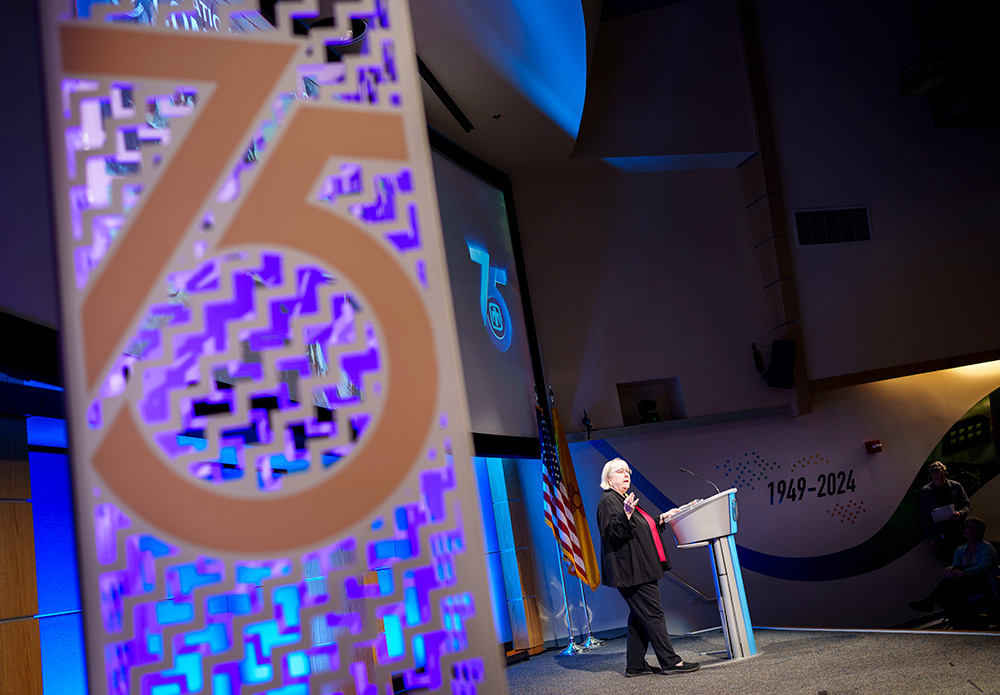Overflow crowd rapt at tales of times Labs stepped up

Sandia is always there” when the nation needs to meet extraordinary challenges, Labs historian Rebecca Ullrich told an overflow crowd in Albuquerque and online last week as the Labs launched its yearlong 75th anniversary celebration.
“The future of Sandia Labs is in your hands,” Labs Director James Peery told the nearly 500 Sandians in the Steve Schiff Auditorium and more than 3,000 online and at California and other sites.
“I see the effort you make every day to innovate, to improve and to move our country forward — just like the generations of Sandians before you.” James said that he believed it was the largest crowd he’d seen since before the COVID-19 pandemic smothered in-person gatherings.
He urged his audience to learn more about Sandia’s history and said he was “proud and honored to reflect on our institution’s enduring legacy of service to this nation.”
Sandia’s origin in the Manhattan Project “set the stage” for 75 years of responsibility and excellence, he said, and today’s Sandians carry on that rich history through their work.
Energy crisis solutions
Associate Labs Director Andy McIlroy, speaking from California, recounted the 40-plus-year history of the Combustion Research Facility and its role in improving transportation efficiency worldwide. Its origins actually go back farther, he said, to Sandia “visionaries” who realized during the energy crisis of the early 1970s how the Labs’ expertise in laser diagnostics and the science of gas transfer systems, based on its nuclear deterrence mission, could be applied to internal combustion engines.
In her talk, “What it means to be a national lab, historically,” Rebecca recounted the many times Sandia stepped up to meet an important national challenge — “beyond mission or assigned milestones” — either when asked or when it volunteered because of its broad portfolio of research and engineering know-how.
She pointed out that innovation is much more than simply one of the Labs’ current goals. “I would say that innovation is actually an observation, a description — it is what Sandia has done and does best.”
Tracing the Labs’ institutional origins in concert with the push by federal science adviser Vannevar Bush for national labs that would keep science “on tap” for the postwar nation, Rebecca explained why Nov. 1, 1949, is Sandia’s birthday to set the stage for her stories of Sandia stepping up.
“I want to give you an idea of the way opportunity looks when it’s standing there knocking,” she said. “Yes, as our grandparents would tell us, it looks like work.”
Stepping up to challenges
The three examples she chose were radically different from each other, but all shared the theme of Sandia taking on challenging projects in unexpected circumstances.
Her first story was how the Labs’ pioneering work with Los Alamos National Laboratory developing sensors to peer down from the Vela satellites or feel vibrations in the Earth to detect nuclear explosions expanded into myriad sensor designs to bolster counterinsurgency during the Vietnam Conflict. A suggestion about the multiple uses for seismic sensors to the Advanced Research Projects Agency led to the growth of sensor expertise into an “ongoing business within Sandia,” she said.
After the USS Iowa gun explosion in 1989, Congress and the Government Accounting Office asked Sandia to investigate the highly publicized incident. A team of more than 40 got to work quickly, discovered a likely cause for the explosion and materials chief Dick Schwoebel presented their findings to Congress, “good science hair” and all, Rebecca quipped.
“The team became evidence that various experts could be pulled together to solve a new problem without a lot of mess,” she said, despite the fact that some hadn’t even met before work began.
Her final example was an investigation of a 2006 explosion at the Sago coal mine in West Virginia. The U.S. Mine Safety and Health Administration asked the Labs to probe whether lightning could have caused the disaster, based on its expertise in electrostatic discharge for stockpile safety.
The team concluded that lightning indeed could have traveled underground to spark a blast in methane gases in the sealed mine shaft, she said.
Sandia through history
Rebecca listed more than a dozen other moments in history where Sandia stepped up, including research for the Strategic Petroleum Reserve and nuclear waste storage, the Unabomber and shoe bomber investigations, the Deepwater Horizon oil spill, the Fukushima disaster and the post-9/11 anthrax attacks.
She peppered her talk with a variety of little-known facts. For example, it wasn’t until 1979 that the three NNSA weapon labs received congressional designation as national laboratories, 32 years after Argonne National Laboratory was chartered as the first national lab.
In conclusion, Rebecca said that being a national lab means that Sandia can apply its decades of research to a panoply of problems that range far beyond its core mission areas.
“It means, the nation can turn to Sandia. That as close to crisis as we all come, somebody — by which I mean you — will be able to bring their minds and tools to bear,” she said.
“I’m just a historian. I’m not selling the place or trying to convince you it’s great,” Rebecca said. “Its greatness is up to you, both in what you contribute and what you judge to be important.”
Watch the entire 75th anniversary launch event here and learn more at the Labs’ external history site. This brand-new website will be updated throughout the year with 75th activities and news.